Andrew Baksh Writing Workshop II
The following pictures of the GlassHouse and the Enid
Haupt Garden were taken on April 22, 1998 at the Rusk Rehabilitation Institute.
These pictures are part of my research project on Horticultural Therapy.
During my visit, I participated in the horticultural workshop and worked
side by side with the patients and therapists. I also visited the outside
garden using a wheel chair, which allowed me to see the garden in a different
perspective. While using the wheelchair, I played the role of a patient
paralyzed on the right side as a result of a stroke. This was done in
an attempt to relate to the patients in the workshop who were all rehabilitating
from various injuries and conditions.
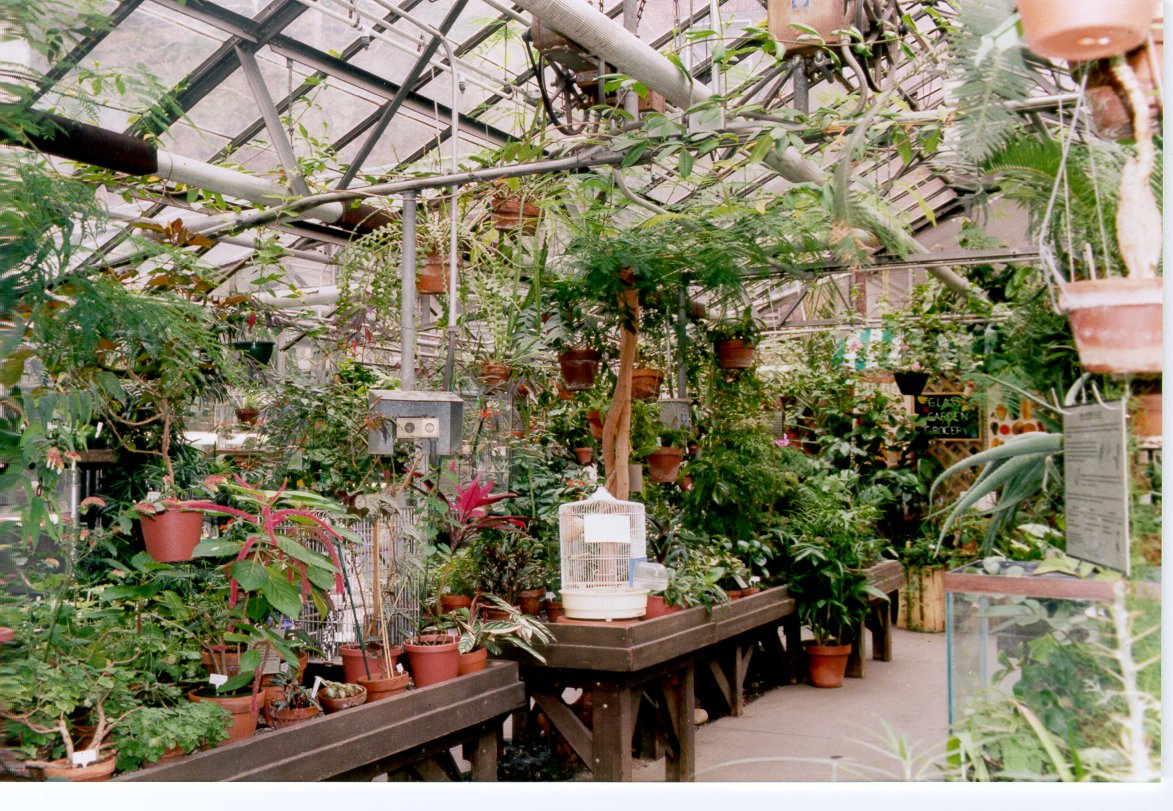 This is inside the Glasshouse
at the Rusk Institute where plants grown by the patients, and workshop
participants are put on display and some sold to the public. Each plant
when potted by the patient is tagged with the name of the plant, the date,
and name of the planter. Thus, begins the re-enforcement of self-discipline
and responsibility, as the plant becomes the sole responsibility of the
patient.
This is inside the Glasshouse
at the Rusk Institute where plants grown by the patients, and workshop
participants are put on display and some sold to the public. Each plant
when potted by the patient is tagged with the name of the plant, the date,
and name of the planter. Thus, begins the re-enforcement of self-discipline
and responsibility, as the plant becomes the sole responsibility of the
patient.
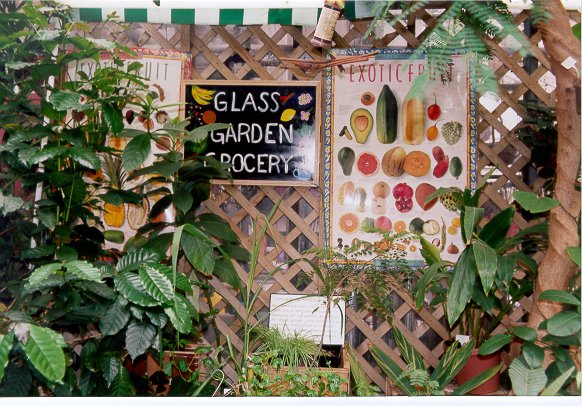 This
picture shows an artificial display of garden fruits and vegetables, all
part of the effort in making the glasshouse colorful and welcoming to all
visitors.
This
picture shows an artificial display of garden fruits and vegetables, all
part of the effort in making the glasshouse colorful and welcoming to all
visitors.
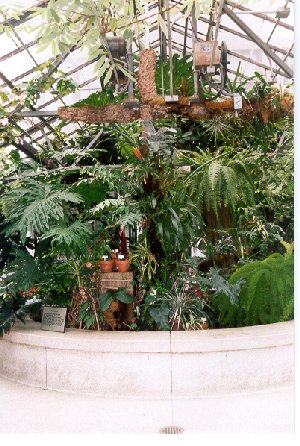 This picture shows
a pond in the glasshouse where tropical plants such as water lilies and
ferns are successfully grown. The pond is also the home for a few (fat)
gold fishes that swim lazily enjoying the peace and calm of their surroundings.
During my visit I observed many visitors sitting on benches next to the
pond reading and taking occasional breaks to watch the fish feed.
This picture shows
a pond in the glasshouse where tropical plants such as water lilies and
ferns are successfully grown. The pond is also the home for a few (fat)
gold fishes that swim lazily enjoying the peace and calm of their surroundings.
During my visit I observed many visitors sitting on benches next to the
pond reading and taking occasional breaks to watch the fish feed.
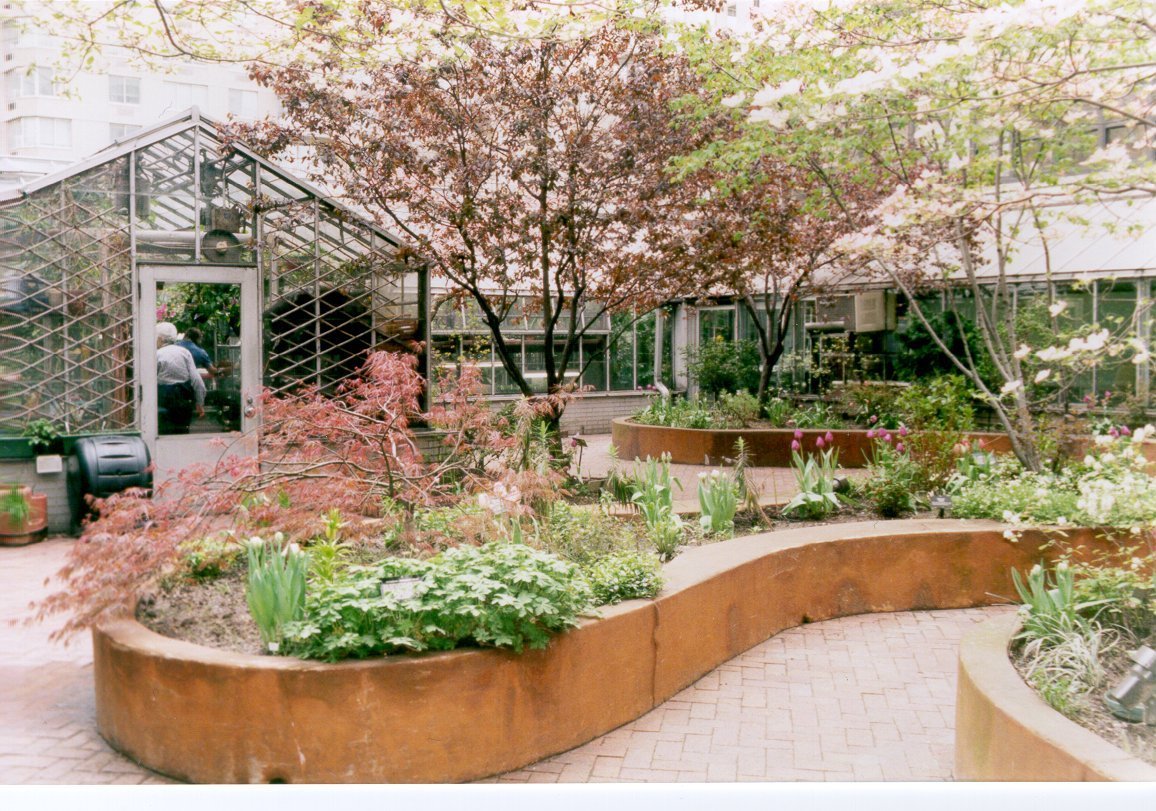 This is the "Enid Haupt"
garden, which adjoins the glass house. It opened on May 13, 1991 and is
a typical urban green space-located in the shadows of buildings with little
sun or exposure to the elements of nature. The plants are low-maintenance
perennials, shrubs, vines and ground covers. The beds are planned so that
something blooms each month through the spring, summer and fall. The most
important feature of this garden is the design, which allows easy
access to visitors in wheelchairs. The pathway is made of brick
to provide a hard, non-slip surface, and it is visually more appealing
than the dull gray look of concrete. To allow easy access by wheel chair
the pathways are at least three feet wide with some areas as wide as six
feet in diameter, this provides easy access to swiveling the wheelchairs.
The doorsills to the pavilion entrances are level and the doors are controlled
by an electric eye for easy access to the garden. Water, electrical outlets,
emergency telephone, and the gas barbecue are all easily accessible from
a wheelchair. Most of the beds in this garden are raised beds, this enables
patients to plant and work the soil from their wheelchairs.
This is the "Enid Haupt"
garden, which adjoins the glass house. It opened on May 13, 1991 and is
a typical urban green space-located in the shadows of buildings with little
sun or exposure to the elements of nature. The plants are low-maintenance
perennials, shrubs, vines and ground covers. The beds are planned so that
something blooms each month through the spring, summer and fall. The most
important feature of this garden is the design, which allows easy
access to visitors in wheelchairs. The pathway is made of brick
to provide a hard, non-slip surface, and it is visually more appealing
than the dull gray look of concrete. To allow easy access by wheel chair
the pathways are at least three feet wide with some areas as wide as six
feet in diameter, this provides easy access to swiveling the wheelchairs.
The doorsills to the pavilion entrances are level and the doors are controlled
by an electric eye for easy access to the garden. Water, electrical outlets,
emergency telephone, and the gas barbecue are all easily accessible from
a wheelchair. Most of the beds in this garden are raised beds, this enables
patients to plant and work the soil from their wheelchairs.
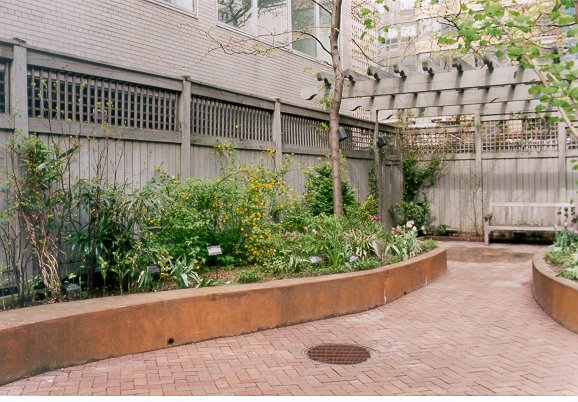
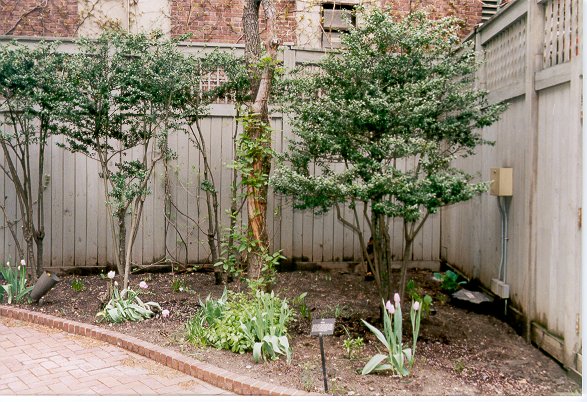
All of the pictures above were photographed by Yocasta Baksh.
 This is inside the Glasshouse
at the Rusk Institute where plants grown by the patients, and workshop
participants are put on display and some sold to the public. Each plant
when potted by the patient is tagged with the name of the plant, the date,
and name of the planter. Thus, begins the re-enforcement of self-discipline
and responsibility, as the plant becomes the sole responsibility of the
patient.
This is inside the Glasshouse
at the Rusk Institute where plants grown by the patients, and workshop
participants are put on display and some sold to the public. Each plant
when potted by the patient is tagged with the name of the plant, the date,
and name of the planter. Thus, begins the re-enforcement of self-discipline
and responsibility, as the plant becomes the sole responsibility of the
patient.
 This
picture shows an artificial display of garden fruits and vegetables, all
part of the effort in making the glasshouse colorful and welcoming to all
visitors.
This
picture shows an artificial display of garden fruits and vegetables, all
part of the effort in making the glasshouse colorful and welcoming to all
visitors.
 This picture shows
a pond in the glasshouse where tropical plants such as water lilies and
ferns are successfully grown. The pond is also the home for a few (fat)
gold fishes that swim lazily enjoying the peace and calm of their surroundings.
During my visit I observed many visitors sitting on benches next to the
pond reading and taking occasional breaks to watch the fish feed.
This picture shows
a pond in the glasshouse where tropical plants such as water lilies and
ferns are successfully grown. The pond is also the home for a few (fat)
gold fishes that swim lazily enjoying the peace and calm of their surroundings.
During my visit I observed many visitors sitting on benches next to the
pond reading and taking occasional breaks to watch the fish feed.
 This is the "Enid Haupt"
garden, which adjoins the glass house. It opened on May 13, 1991 and is
a typical urban green space-located in the shadows of buildings with little
sun or exposure to the elements of nature. The plants are low-maintenance
perennials, shrubs, vines and ground covers. The beds are planned so that
something blooms each month through the spring, summer and fall. The most
important feature of this garden is the design, which allows easy
access to visitors in wheelchairs. The pathway is made of brick
to provide a hard, non-slip surface, and it is visually more appealing
than the dull gray look of concrete. To allow easy access by wheel chair
the pathways are at least three feet wide with some areas as wide as six
feet in diameter, this provides easy access to swiveling the wheelchairs.
The doorsills to the pavilion entrances are level and the doors are controlled
by an electric eye for easy access to the garden. Water, electrical outlets,
emergency telephone, and the gas barbecue are all easily accessible from
a wheelchair. Most of the beds in this garden are raised beds, this enables
patients to plant and work the soil from their wheelchairs.
This is the "Enid Haupt"
garden, which adjoins the glass house. It opened on May 13, 1991 and is
a typical urban green space-located in the shadows of buildings with little
sun or exposure to the elements of nature. The plants are low-maintenance
perennials, shrubs, vines and ground covers. The beds are planned so that
something blooms each month through the spring, summer and fall. The most
important feature of this garden is the design, which allows easy
access to visitors in wheelchairs. The pathway is made of brick
to provide a hard, non-slip surface, and it is visually more appealing
than the dull gray look of concrete. To allow easy access by wheel chair
the pathways are at least three feet wide with some areas as wide as six
feet in diameter, this provides easy access to swiveling the wheelchairs.
The doorsills to the pavilion entrances are level and the doors are controlled
by an electric eye for easy access to the garden. Water, electrical outlets,
emergency telephone, and the gas barbecue are all easily accessible from
a wheelchair. Most of the beds in this garden are raised beds, this enables
patients to plant and work the soil from their wheelchairs.

